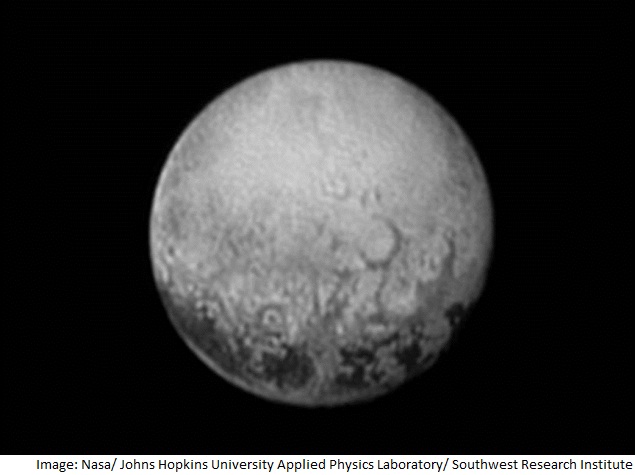- Home
- Science
- Science News
- Nasa's New Horizons Probe Takes Last Portrait of Pluto's Puzzling Spots
Nasa's New Horizons Probe Takes Last Portrait of Pluto's Puzzling Spots

The spots appear on the side of Pluto that always faces its largest moon Charon - the face that will be invisible to New Horizons when the spacecraft makes its close flyby on July 14.
The large dark areas are estimated to be 300 miles across, an area roughly the size of the state of Missouri.
The image is the last, best look that anyone will have of Pluto's far side for decades to come, said Alan Stern, New Horizons principal investigator from Southwest Research Institute in Colorado.
The spots are connected to a dark belt that circles Pluto's equatorial region.
It is weird that they are spaced so regularly, added New Horizons programme scientist Curt Niebur.
"We cannot tell whether they are plateaus or plains or whether they are brightness variations on a completely smooth surface," said Jeff Moore of Nasa's Ames Research Center in California.
In comparison with earlier images, the dark areas are more complex than they initially appeared, while the boundaries between the dark and bright terrains are irregular and sharply defined.
New Horizons is currently three billion miles away from the Earth and just two-and-half million miles from Pluto.
On July 14, New Horizons will pass about 12,500 km from Pluto.
It will zip past Pluto at 49,600 km per hour, with a suite of seven science instruments busily gathering data.
The mission will complete the initial reconnaissance of the solar system with the first-ever look at the icy dwarf planet.
Get your daily dose of tech news, reviews, and insights, in under 80 characters on Gadgets 360 Turbo. Connect with fellow tech lovers on our Forum. Follow us on X, Facebook, WhatsApp, Threads and Google News for instant updates. Catch all the action on our YouTube channel.
Related Stories
- Samsung Galaxy Unpacked 2025
- ChatGPT
- Redmi Note 14 Pro+
- iPhone 16
- Apple Vision Pro
- Oneplus 12
- OnePlus Nord CE 3 Lite 5G
- iPhone 13
- Xiaomi 14 Pro
- Oppo Find N3
- Tecno Spark Go (2023)
- Realme V30
- Best Phones Under 25000
- Samsung Galaxy S24 Series
- Cryptocurrency
- iQoo 12
- Samsung Galaxy S24 Ultra
- Giottus
- Samsung Galaxy Z Flip 5
- Apple 'Scary Fast'
- Housefull 5
- GoPro Hero 12 Black Review
- Invincible Season 2
- JioGlass
- HD Ready TV
- Laptop Under 50000
- Smartwatch Under 10000
- Latest Mobile Phones
- Compare Phones
- Honor Win RT
- Honor Win
- Xiaomi 17 Ultra Leica Edition
- Xiaomi 17 Ultra
- Huawei Nova 15
- Huawei Nova 15 Pro
- Huawei Nova 15 Ultra
- OnePlus 15R
- Asus ProArt P16
- MacBook Pro 14-inch (M5, 2025)
- OPPO Pad Air 5
- Huawei MatePad 11.5 (2026)
- Xiaomi Watch 5
- Huawei Watch 10th Anniversary Edition
- Acerpure Nitro Z Series 100-inch QLED TV
- Samsung 43 Inch LED Ultra HD (4K) Smart TV (UA43UE81AFULXL)
- Asus ROG Ally
- Nintendo Switch Lite
- Haier 1.6 Ton 5 Star Inverter Split AC (HSU19G-MZAID5BN-INV)
- Haier 1.6 Ton 5 Star Inverter Split AC (HSU19G-MZAIM5BN-INV)

















